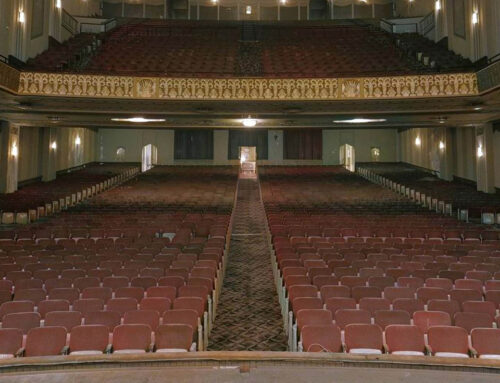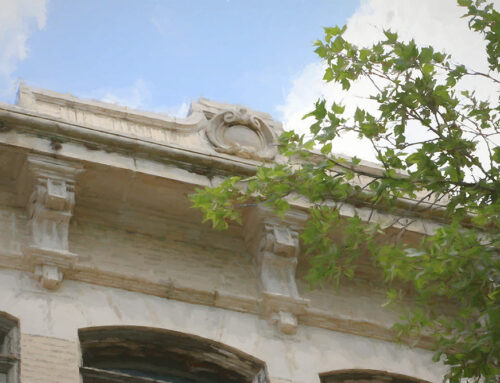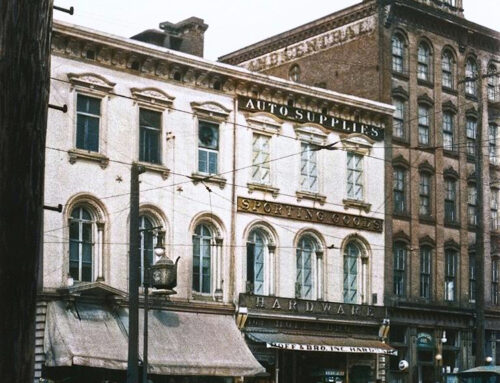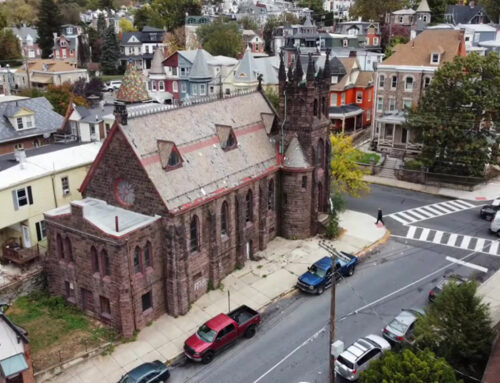From 1770 to 1847 the Berks County jail was located at the northeast corner of the Fifth and Washington Streets. This jail was an old two-story stone building erected in 1770.
The jail lot, 230 feet by 61 feet, 4 inches, included a prison yard enclosed by a stone wall 20 feet high. The sheriff and his family occupied both rooms at the eastern end of the building and the sheriff’s offices, two adjoining rooms, were located on the first floor at the western end of the building. Four rooms for prisoners occupied the second floor over the sheriff’s offices. The cellar housed the bake oven and two dungeons, reminiscent of European justice.

Part of the old jail building at Fifth and Washington streets was used as a tavern. Conrad Feger was elected sheriff in 1805 and he secured a license in the name of his son Peter to conduct a tavern in the jail building. Whiskey was selling then at three cents a glass. He sold liquor there until George Marks became sheriff in 1809 when the tavern was closed.
Customers used to play ball in the prison yard while the prisoners played cards on the second floor. There was a card table in each of the cells, the doors of which were all open in the daytime so that the prisoners could commingle. After the tavern was closed the prisoners secured whiskey by hanging strings out through the grated windows of the second story and friends tied bottles filed with the liquor to the strings and these were pulled up and the prisoners occasionally became greatly intoxicated.
The laws were very strict in this period and were relentlessly carried out with rigid adherence to English law. In that era political prisoners and high-ranking prisoners of war were occasionally incarcerated, but few common criminals could expect such treatment. Almost the only time commoners were locked away was while awaiting trial – once a verdict was delivered they were punished on the spot or released. This place of confinement, then, was properly speaking not a prison but a jail – often spelled “gaol” or “goal” in the eighteenth century. The only offense for which long-term imprisonment was common was debt.
Prior to the passage of the Act of April 10, 1834 all persons convicted of murder in this county were executed in public. The persons to be executed were hung at the foot of Penn’s Mount, at what was known as the “gravel hole,” in the old Fair Ground in Penn’s Common (now included within the territory acquired by the city and occupied as a public park). On June 10, 1809 thousands of people gathered in City Park to witness the hanging of Susanna Cox. The 24-year-old was hung after being convicted of killing her infant son.
The 1834 law required that persons convicted of murder should be hung in the jail yard, and that but a limited number of persons should be present. The first person hung under the new law in this county was Nicholas Reinhart. Although the prison was used for almost a century, Nicholas Reinhart has the dubious distinction of being the only person hanged in the old jail yard.
Nicholas Reinhart was convicted of murdering Conrad Christ of Bern Township in June 1841. Reinhart and John F. Oshman allegedly robbed Christ and fled to Ohio, where they were captured and returned to Berks County. They were tried separately. The trial lasted over a week. Nicholas Reinhart was found guilty of murder in the first degree. Oshman was acquitted. Reinhart tried on several occasions to escape from prison, and on one occasion he was so far successful as to scale the walls and get as far as Penn’s Mount. The Sheriff immediately gave the alarm and hundreds of persons engaged in the pursuit and he was finally captured by Samuel Ritter. Mr. Ritter was compelled to shoot at and slightly wound him before he would surrender. Reinhart was hung in the yard of the old jail at Fifth and Washington streets. The day of the execution Trinity Lutheran church steeple and the roof of the building adjoining the prison on the north were crowded with people who were desirous of witnessing it.
In 1847, commissioners John Sherman, Michael Gery, and Fred Printz engaged John Haviland of Philadelphia, the foremost architect of his day, to design an appropriate structure in keeping with the principle of separate-and-solitary confinement. The new prison, completed in 1848 at a cost of $17,000, stood at the head of Penn Street on a lot that measured 170 feet across the front and 300 feet deep. This parcel, the exact boundaries of which remain intact, is now set apart for the exclusive use of police vehicles and personnel. The original front steps of the prison also survive here as convenient points of reference.
The old jail at the corner of Fifth and Washington Streets became a tourist attraction. It was used for other purposes, including a barbershop operated by Aaron Still, and a grocery operated by Edward Burkholder until 1909 when the old jail was demolished to clear the way for the construction of the Berkshire Hotel. Hundreds of people gathered about the corner when the old jail was torn down. Many relics were found but the stories of an old Indian cemetery, a possibility of unearthing something from dungeon and hidden pots of gold did not materialize.









Leave A Comment